Prediction of Modulus of Elasticity of Concrete Using Different Homogenization Methods
Highlights
- Iterative strategy can improve the prediction accuracy of homogenization method;
- Optimal application scenarios for each homogenization method are clarified;
- Symbolic numerical hybrid computing frameworks are implemented by Mathematica;
- The universality of homogenization methods is validated by multiple datasets.
Abstract
1. Introduction
2. Simulation Methods
2.1. Iterative Method
2.2. Dilute-Distribution Solution Method
- (1)
- Sparse iteration method
2.3. Mori–Tanaka Method
2.4. Self-Consistency Method
2.5. Generalized Self-Consistent Method
2.6. Differential Method
2.7. Voigt Method and Reuss Method
2.8. Overview of Mathematica Software and Its Application in This Study
3. Simulation Results
3.1. Influence of Aggregate Volume Fraction
3.1.1. Analysis of Stock Test Case Examples
3.1.2. Validation of Various Micromechanical Direct Methods
3.1.3. Validation of Various Micromechanical Iterative Methods
3.2. Analysis of the Influence of Different Types of Aggregates on Cement Matrix
3.2.1. The Influence of Different Types of Aggregates
3.2.2. Impact of Different Types of Cement Matrix
4. Conclusions and Discussion
4.1. Conclusions
4.2. Discussion
Author Contributions
Funding
Institutional Review Board Statement
Informed Consent Statement
Data Availability Statement
Conflicts of Interest
References
- Gerges, N.N.; Issa, C.A.; Sleiman, E.; Aintrazi, S.; Saadeddine, J.; Abboud, R.; Antoun, M. Eco-friendly optimum structural concrete mix design. Sustainability 2022, 14, 8660. [Google Scholar] [CrossRef]
- Wang, J.; Long, G.; Xiang, Y.; Dong, R.; Tang, Z.; Xiao, Q.; Yang, Z.; Ma, K. Influence of rapid curing methods on concrete microstructure and properties: A review. Case Stud. Constr. Mater. 2022, 17, e01600. [Google Scholar] [CrossRef]
- Hajek, M.; Decky, M.; Drusa, M.; Orininová, L.; Scherfel, W. Elasticity Modulus and Flexural Strength Assessment of Foam Concrete Layer of Poroflow. IOP Conf. Ser. Earth Environ. Sci. 2016, 44, 022021. [Google Scholar] [CrossRef]
- Zhang, Y.; Ren, W.; Chen, Y.; Mi, Y.; Lei, J.; Sun, L. Predicting the compressive strength of high-performance concrete using an interpretable machine learning model. Sci. Rep. 2024, 14, 28346. [Google Scholar] [CrossRef]
- Dong, S.; Gu, J.; Ouyang, X.; Jang, S.-H.; Han, B. Enhancing mechanical properties, durability and multifunctionality of concrete structures via using ultra-high performance concrete layer: A review. Compos. B Eng. 2025, 112329. [Google Scholar] [CrossRef]
- Wang, Y.; Damien, D.; Xi, Y. Micro- and meso-mechanical modeling of effect of freezing on modulus of elasticity of concrete. Eng. Fract. Mech. 2018, 200, 401–417. [Google Scholar] [CrossRef]
- Ihteshaam, M.I.; Jin, F.; Xu, X. A mesoscale comparative analysis of the elastic modulus in rock-filled concrete for structural applications. Buildings 2024, 14, 3171. [Google Scholar] [CrossRef]
- Gao, Y.; Han, X.; Su, X. Analysis of applicability and influencing factors of elastic modulus prediction model of lightweight aggregate concrete. Constr. Build. Mater. 2025, 462, 140022. [Google Scholar] [CrossRef]
- Pal, B.; Ramaswamy, A. A multi-physics-based approach to predict mechanical behavior of concrete element in a multi-scale framework. Mech. Mater. 2023, 176, 104509. [Google Scholar] [CrossRef]
- Abbas, E.; Al-Zuhairi, A. Effect of maximum size of aggregate on the behavior of reinforced concrete beams analyzed using mesoscale modeling. J. Eng. 2020, 26, 143–155. [Google Scholar] [CrossRef]
- Wittmann, F.H. Structure of Concrete and Crack Formation. In Fracture of Non-Metallic Materials: Proceeding of the 5th Advanced Seminar on Fracture Mechanics, Joint Research Centre, Ispra, Italy, 14–18 October 1985; Herrmann, K.P., Larsson, L.H., Eds.; Springer: Dordrecht, The Netherlands, 1987; pp. 309–340. [Google Scholar]
- Piccolroaz, A.; Bigoni, D.; Gajo, A. An elastoplastic framework for granular materials becoming cohesive through mechanical densification. Part II—The formulation of elastoplastic coupling at large strain. Eur. J. Mech.—A/Solids 2006, 25, 358–369. [Google Scholar] [CrossRef]
- Chen, H.J.; Peng, H.S.; Chen, Y.F. Numerical analysis of shrinkage stresses in a mass concrete. J. Chin. Inst. Eng. 2004, 27, 357–365. [Google Scholar] [CrossRef]
- Oshita, H.; Tanabe, T.-a. Modeling of water migration phenomenon in concrete as homogeneous material. J. Eng. Mech. 2000, 126, 551–553. [Google Scholar] [CrossRef]
- Bai, W.; Geng, Y.; Yuan, C.; Guan, J.; Xie, C.; Li, L. Mesoscopic damage behavior of recycled aggregate concrete modified with metakaolin under the combined effects of freeze–thaw cycles and sulfate attack. Arch. Civil. Mech. Eng. 2025, 25, 91. [Google Scholar] [CrossRef]
- Jivkov, A.P. Structure of micro-crack population and damage evolution in quasi-brittle media. Theor. Appl. Fract. Mech. 2014, 70, 1–9. [Google Scholar] [CrossRef]
- Zaitsev, J.; Wittmann, F. Crack propagation in a two-phase material such as concrete. Fracture 1977, 3, 1197–1203. [Google Scholar]
- Liu, X.; Yang, R.; Bie, Z.; Nie, F.; Fan, Y.; Oterkus, E.; He, X. Enhanced interfacial thermal transport in diamond nanothread reinforced polymer nanocomposites: Insights from atomistic simulations and density functional theory. Nanoscale 2025, 17, 13419–13433. [Google Scholar] [CrossRef]
- Nie, F.; Su, X.; Wang, M.; Ma, X.; Ou, K.; Liu, J.; Lin, H. Debonding of asphalt-aggregate interface under coupled moisture and temperature conditions: An atomistic study. Case Stud. Constr. Mater. 2025, 22, e04554. [Google Scholar] [CrossRef]
- Nie, F.; Bie, Z.; Lin, H. Investigating the advanced thermomechanical properties of coiled carbon nanotube modified asphalt. Constr. Build. Mater. 2024, 441, 137512. [Google Scholar] [CrossRef]
- Li, C.Q.; Zhou, J.; Tao, M.; Du, K.; Wang, S.F.; Armaghani, D.J.; Mohamad, E.T. Developing hybrid ELM-ALO, ELM-LSO and ELM-SOA models for predicting advance rate of TBM. Transp. Geotech. 2022, 36, 100819. [Google Scholar] [CrossRef]
- Li, C.Q.; Zhou, J.; Dias, D.; Gui, Y.L. A Kernel Extreme Learning Machine-Grey Wolf Optimizer (KELM-GWO) Model to Predict Uniaxial Compressive Strength of Rock. Appl. Sci. 2022, 12, 8468. [Google Scholar] [CrossRef]
- Grassl, P. A lattice approach to model flow in cracked concrete. Cem. Concr. Compos. 2009, 31, 454–460. [Google Scholar] [CrossRef]
- Vidya Sagar, R.; Raghu Prasad, B.K.; Nazreen, S.; Singh, R.K. Modeling mode-I fracture process in concrete at meso-scale: Computational aspects of lattice model and a comparison between results of two dimensional lattice simulation and acoustic emission measurements. Eng. Fract. Mech. 2019, 210, 257–278. [Google Scholar] [CrossRef]
- Xia, Y.; Wu, W.; Yang, Y.; Fu, X. Mesoscopic study of concrete with random aggregate model using phase field method. Constr. Build. Mater. 2021, 310, 125199. [Google Scholar] [CrossRef]
- Wei, S.; Wang, D.; Wang, X.; Zhang, H.; Cao, H.; Liu, Q. Research on the random generation model of 2D irregular aggregates in concrete based on fast grid region division method and its ground penetrating radar characteristics. Case Stud. Constr. Mater. 2024, 21, e03932. [Google Scholar] [CrossRef]
- Wan-cheng, Z.H.U.; Chun-an, T.; Wen, Z.; Jin-guang, T. Numerical simulation on the fracture process of concrete specimen under static loading. Eng. Mech. 2002, 19, 148–153. [Google Scholar]
- Bažant Zdeněk, P.; Tabbara Mazen, R.; Kazemi Mohammad, T.; Pijaudier-Cabot, G. Random Particle Model for Fracture of Aggregate or Fiber Composites. J. Eng. Mech. 1990, 116, 1686–1705. [Google Scholar] [CrossRef]
- Yang, L.; Li, K.; Hu, X.; Peng, Z.; Liu, Q.-f.; Shi, C. Mesoscopic discrete modeling of compression and fracture behavior of concrete: Effects of aggregate size distribution and interface transition zone. Cem. Concr. Compos. 2024, 147, 105411. [Google Scholar] [CrossRef]
- Bažant Zdeněk, P.; Caner Ferhun, C.; Adley Mark, D.; Akers Stephen, A. Fracturing Rate Effect and Creep in Microplane Model for Dynamics. J. Eng. Mech. 2000, 126, 962–970. [Google Scholar] [CrossRef]
- Tue, N.V.; Li, J.; Caner, F.C. Microplane constitutive model M4L for concrete. I: Theory. Comput. Struct. 2013, 128, 219–229. [Google Scholar] [CrossRef]
- Peng, Y.; Zakaria, S.; Sun, Y.; Chen, Y.; Zhang, L. Analysis of tensile strength and failure mechanism based on parallel homogenization model for recycled concrete. Materials 2022, 15, 145. [Google Scholar] [CrossRef] [PubMed]
- Sivtsev, P.V. Simplified numerical homogenization method for the plasticity problem with isotropic hardening. Lobachevskii J. Math. 2023, 44, 4157–4169. [Google Scholar] [CrossRef]
- Li, Y.; Liu, Y.Z.; Li, Y.N.; Li, Y.Q.; Wang, R. Evaluation of concrete creep properties based on indentation test and multiscale homogenization method. Cem. Concr. Compos. 2021, 123, 104135. [Google Scholar] [CrossRef]
- Zouari, R.; Benhamida, A.; Dumontet, H. A micromechanical iterative approach for the behavior of polydispersed composites. Int. J. Solids Struct. 2008, 45, 3139–3152. [Google Scholar] [CrossRef]
- Parsaee, A.; Shokrieh, M.M.; Mondali, M. A micro–macro homogenization scheme for elastic composites containing high volume fraction multi-shape inclusions. Comput. Mater. Sci. 2016, 121, 217–224. [Google Scholar] [CrossRef]
- Ke, Y.; Ortola, S.; Beaucour, A.L.; Dumontet, H. Identification of microstructural characteristics in lightweight aggregate concretes by micromechanical modelling including the interfacial transition zone (ITZ). Cem. Concr. Res. 2010, 40, 1590–1600. [Google Scholar] [CrossRef]
- Mori, T.; Tanaka, K. Average stress in matrix and average elastic energy of materials with misfitting inclusions. Acta Metall. 1973, 21, 571–574. [Google Scholar] [CrossRef]
- Benveniste, Y. A new approach to the application of Mori-Tanaka’s theory in composite materials. Mech. Mater. 1987, 6, 147–157. [Google Scholar] [CrossRef]
- Raju, B.; Hiremath, S.R.; Roy Mahapatra, D. A review of micromechanics based models for effective elastic properties of reinforced polymer matrix composites. Compos. Struct. 2018, 204, 607–619. [Google Scholar] [CrossRef]
- Budiansky, B. On the elastic moduli of some heterogeneous materials. J. Mech. Phys. Solids 1965, 13, 223–227. [Google Scholar] [CrossRef]
- Christensen, R.M. A Critical Evaluation for a Class of Micro-Mechanics Models. In Inelastic Deformation of Composite Materials; Dvorak, G.J., Ed.; Springer: New York, NY, USA, 1991; pp. 275–282. [Google Scholar]
- Voigt, W. Ueber die Beziehung zwischen den beiden Elasticitätsconstanten isotroper Körper. Ann. Der Phys. 1889, 274, 573–587. [Google Scholar] [CrossRef]
- Reuss, A. Berechnung der Fließgrenze von Mischkristallen auf Grund der Plastizitätsbedingung für Einkristalle. ZAMM—J. Appl. Math. Mech./Z. Für Angew. Math. Und Mech. 1929, 9, 49–58. [Google Scholar] [CrossRef]
- Stock, A.F.; Hannantt, D.J.; Williams, R.I.T. The effect of aggregate concentration upon the strength and modulus of elasticity of concrete. Mag. Concr. Res. 1979, 31, 225–234. [Google Scholar] [CrossRef]
- Zhou, F.P.; Lydon, F.D.; Barr, B.I.G. Effect of coarse aggregate on elastic modulus and compressive strength of high performance concrete. Cem. Concr. Res. 1995, 25, 177–186. [Google Scholar] [CrossRef]
- Heyang, N. Study on Elastic Modulus of Concrete Based on Mesomechanical Model. Master’s Thesis, Henan University, Kaifeng, China, 2016. (In Chinese). [Google Scholar]
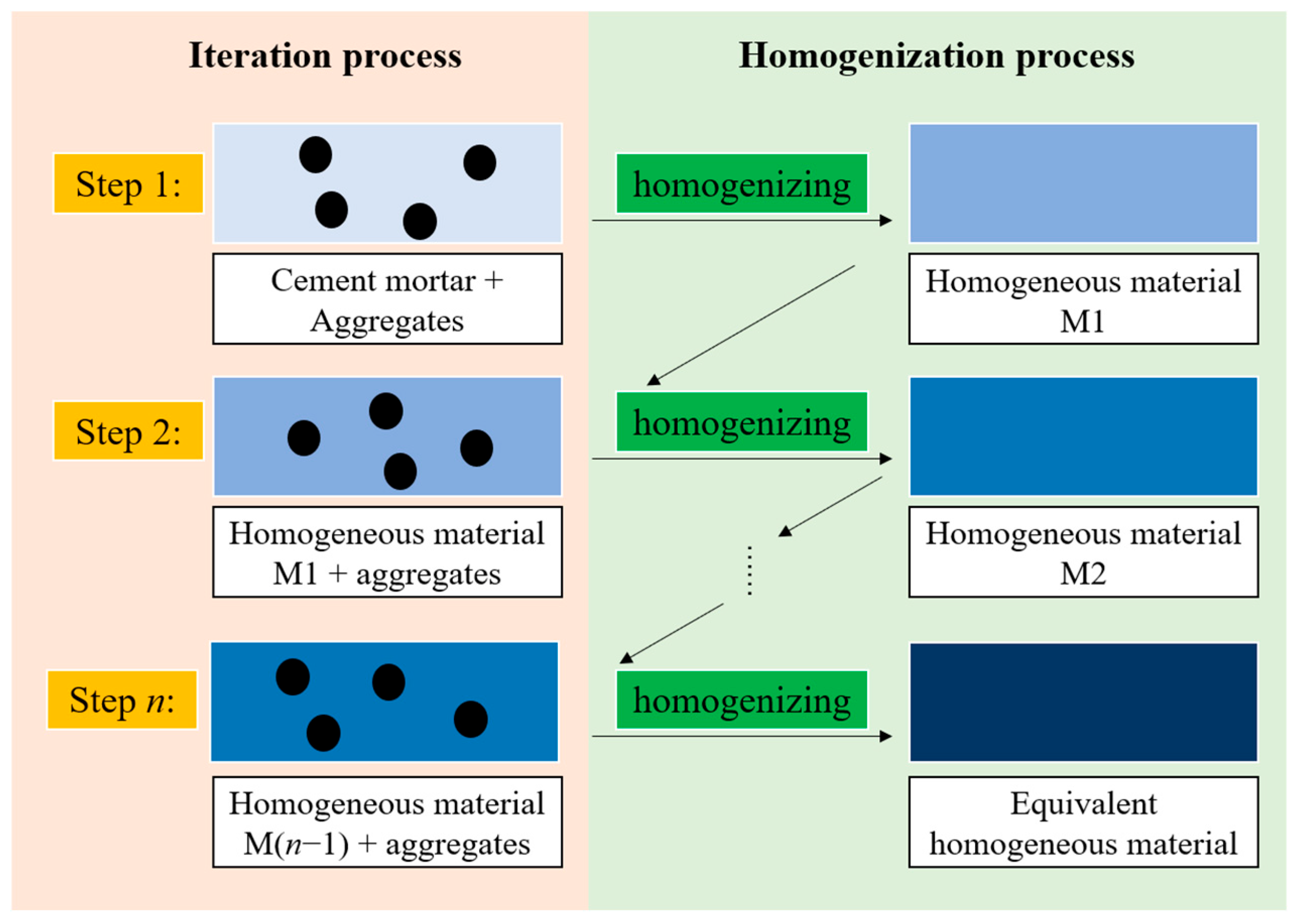
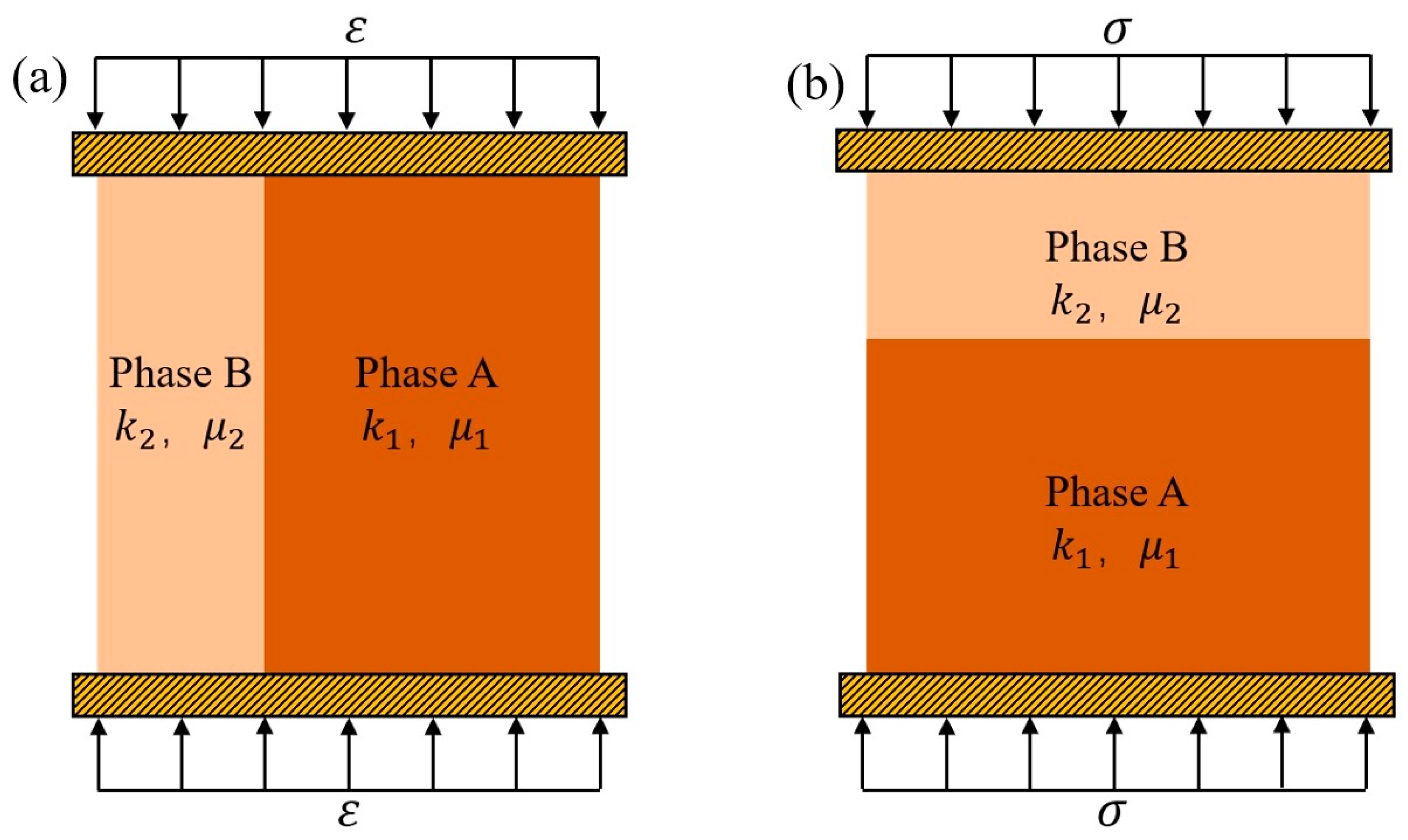
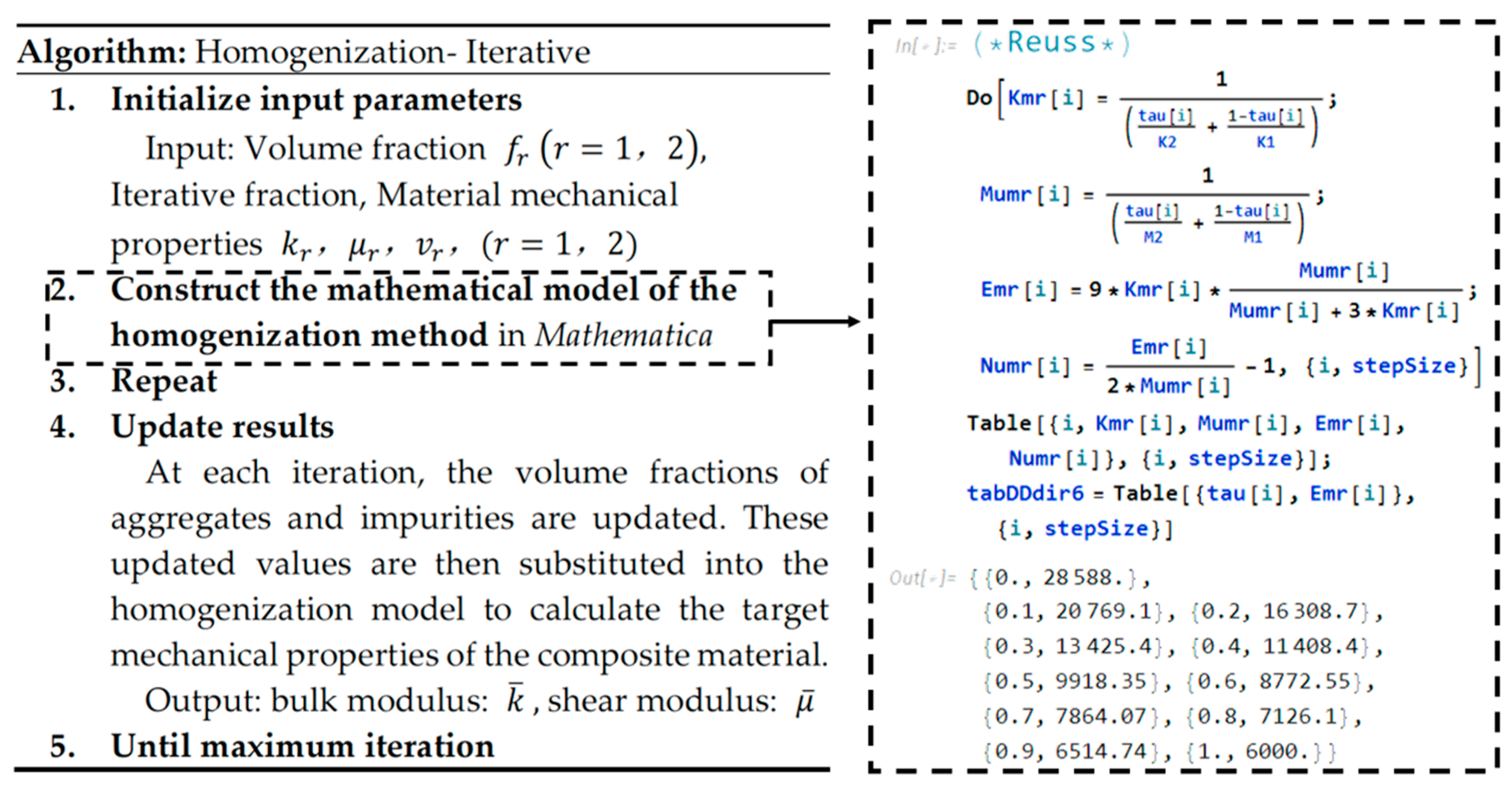

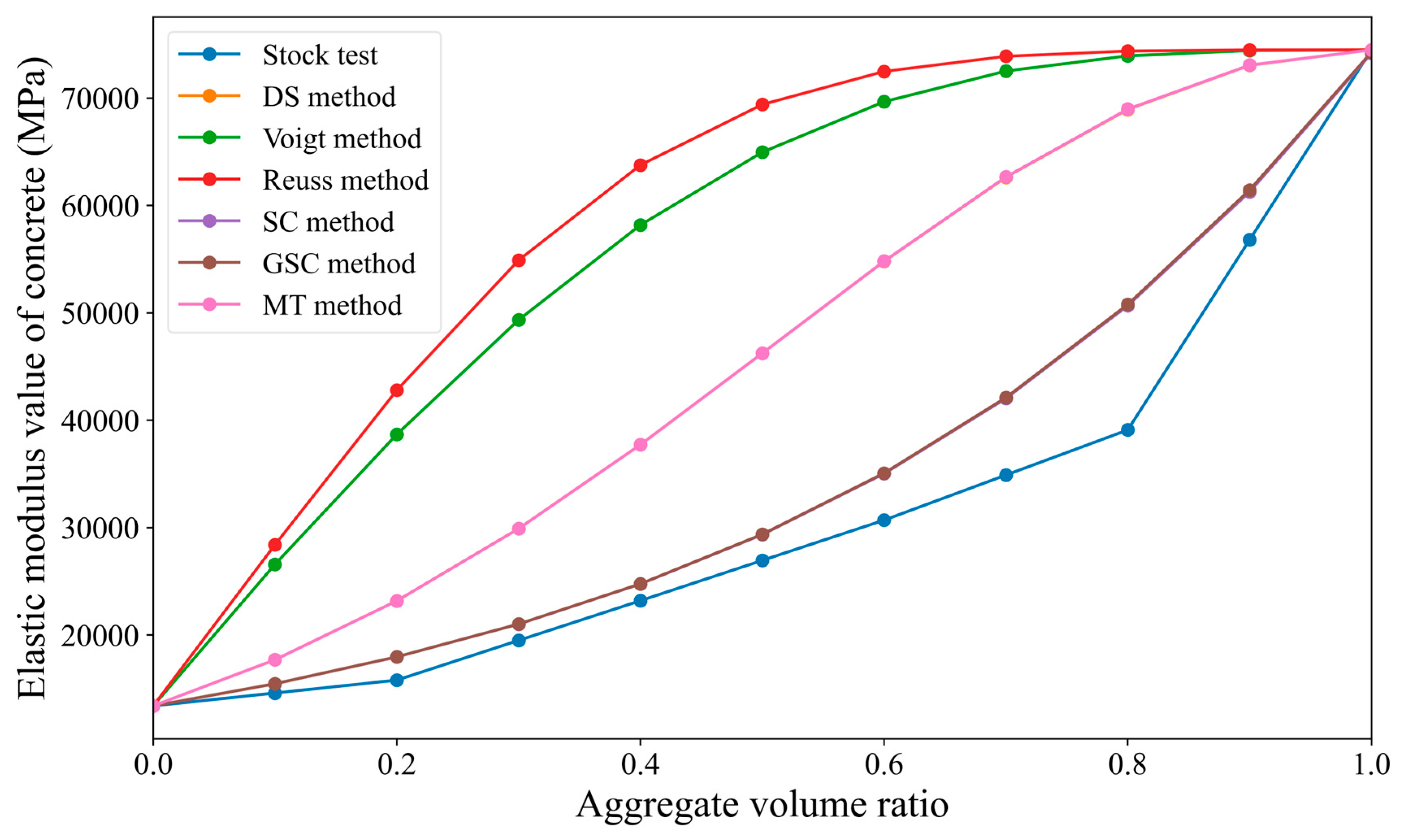

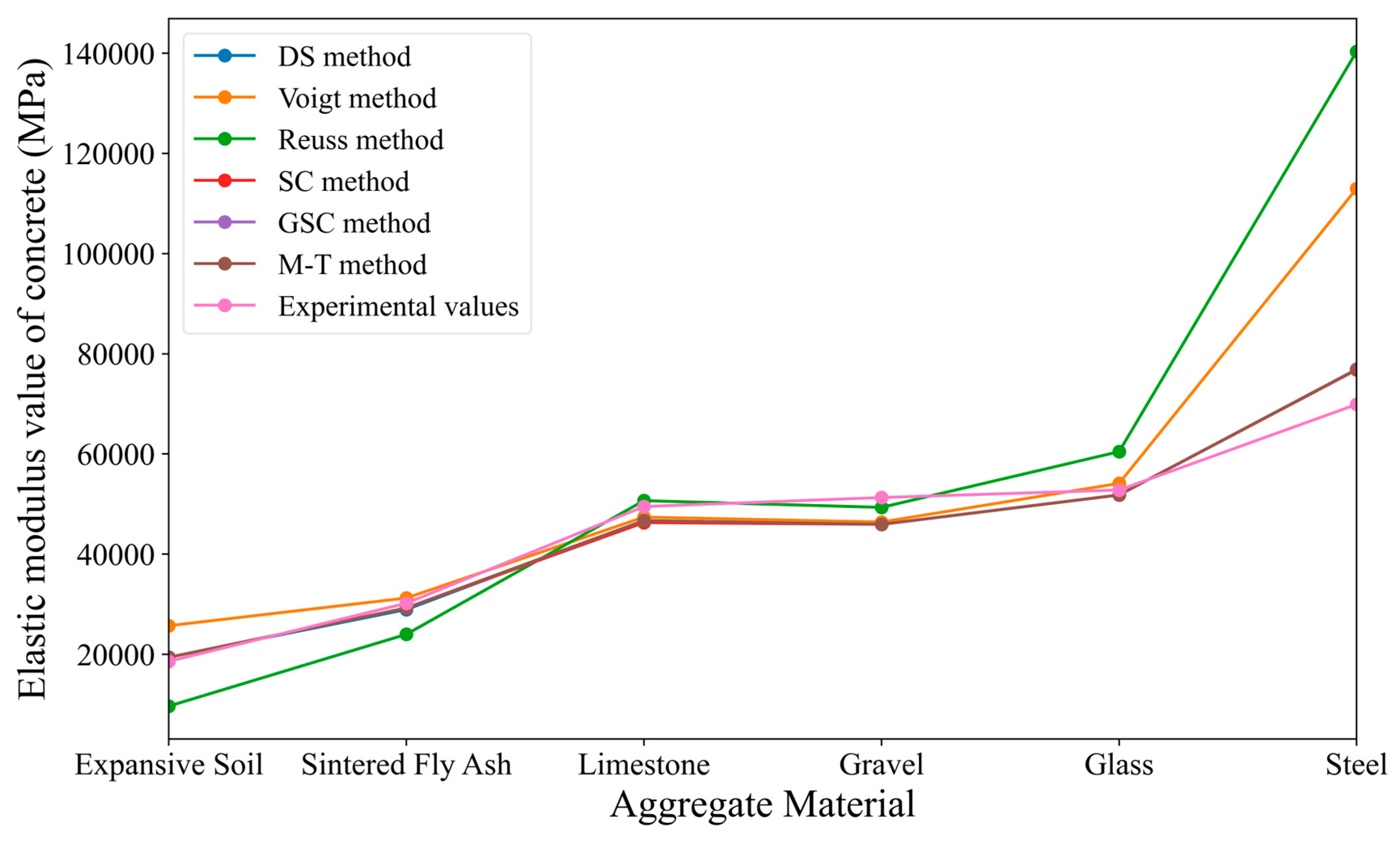
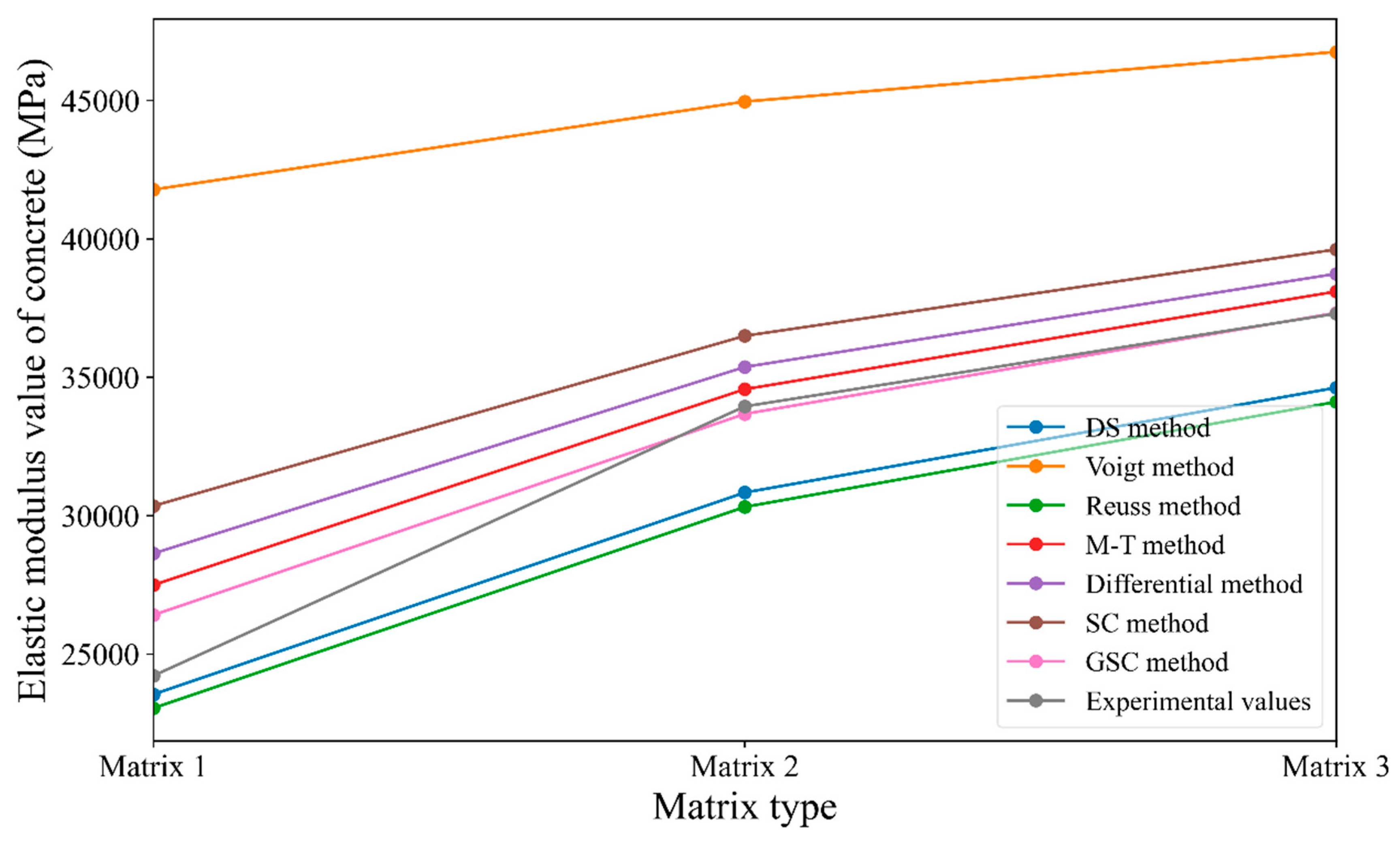
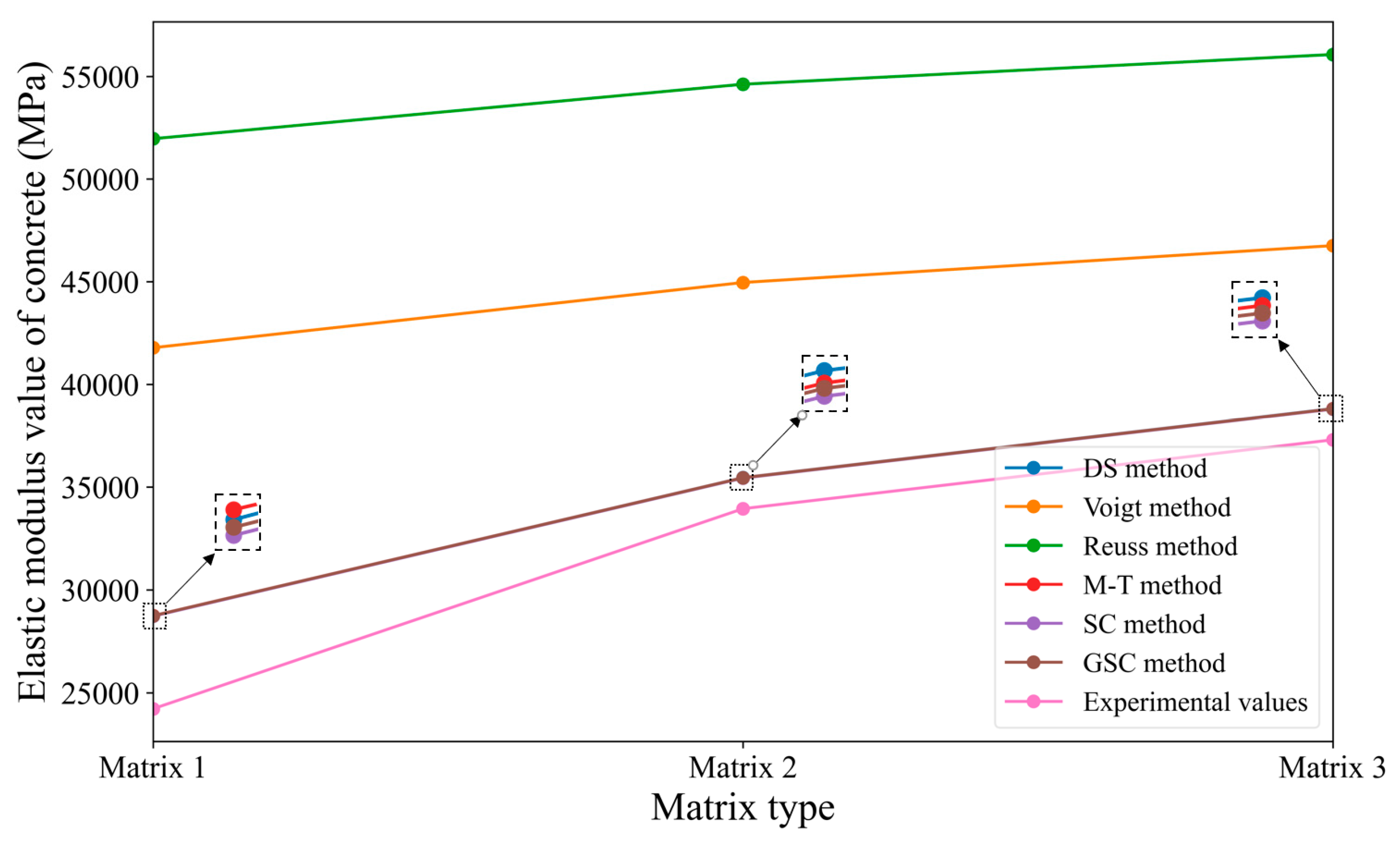
| Two-Phase Materials | Elastic Modulus /GPa | Poisson’s Ratio |
|---|---|---|
| Aggregate phase | 74.5 | 0.15 |
| Cement matrix phase | 13.4 | 0.25 |
| Aggregate Volume Ratio | /MPa | |||||||
|---|---|---|---|---|---|---|---|---|
| Stock Test | DS Method | Voigt Method | Reuss Method | SC Method | GSC Method | M-T Method | Differential Method | |
| 0 | 13,400 | 13,400 | 13,400 | 13,400 | 13,400 | 13,400 | 13,400 | 13,400 |
| 0.1 | / | 15,274 | 19,635 | 14,597 | 19,608 | 15,417 | 15,414 | 15,464 |
| 0.2 | 15,800 | 17,144 | 25,798 | 16,029 | 22,558 | 17,736 | 17,751 | 17,969 |
| 0.3 | / | 19,012 | 31,925 | 17,773 | 26,221 | 20,340 | 20,496 | 21,025 |
| 0.4 | 23,200 | 20,879 | 38,031 | 19,942 | 30,742 | 23,165 | 23,766 | 24,774 |
| 0.5 | / | 22,744 | 44,124 | 22,714 | 31,776 | 26,103 | 27,730 | 29,392 |
| 0.6 | 30,700 | 24,608 | 50,209 | 26,382 | 38,498 | 29,005 | 32,635 | 35,092 |
| 0.7 | / | 26,472 | 56,287 | 31,462 | 46,294 | 31,667 | 38,863 | 42,135 |
| 0.8 | 39,100 | 28,334 | 62,361 | 38,966 | 55,009 | 33,817 | 47,034 | 50,821 |
| 0.9 | / | 30,196 | 68,432 | 51,169 | 64,465 | 35,086 | 58,227 | 61,488 |
| 1 | 74,500 | 32,058 | 74,500 | 74,500 | 74,500 | 34,986 | 74,500 | 74,500 |
| Aggregate Volume Ratio | /MPa | ||||||
|---|---|---|---|---|---|---|---|
| Stock Test | DS Method | Voigt Method | Reuss Method | SC Method | GSC Method | M-T Method | |
| 0 | 13,400 | 13,400 | 13,400 | 13,400 | 13,400 | 13,400 | 13,400 |
| 0.1 | / | 17,697 | 26,586 | 28,414 | 15,463 | 15,464 | 17,695 |
| 0.2 | 15,800 | 23,186 | 38,689 | 42,804 | 17,965 | 17,968 | 23,179 |
| 0.3 | / | 29,914 | 49,349 | 54,910 | 21,015 | 21,023 | 29,905 |
| 0.4 | 23,200 | 37,732 | 58,188 | 63,773 | 24,753 | 24,769 | 37,725 |
| 0.5 | / | 46,239 | 64,967 | 69,408 | 29,353 | 29,383 | 46,243 |
| 0.6 | 30,700 | 54,800 | 69,670 | 72490 | 35,028 | 35,078 | 54,819 |
| 0.7 | / | 62,637 | 72,523 | 73,,896 | 42,034 | 42,114 | 62,667 |
| 0.8 | 39,100 | 68,950 | 73,942 | 74,388 | 50,671 | 50,790 | 68,981 |
| 0.9 | / | 73,057 | 74,435 | 74,493 | 61,274 | 61,446 | 73,077 |
| 1 | 74,500 | 74,500 | 74,500 | 74,500 | 74,172 | 74,275 | 74,500 |
| Aggregate Material | Ed/Gpa | Poisson’s Ratio | Volume Fraction | Ed/Gpa |
|---|---|---|---|---|
| Expansive Clay | 5.2 | 0.29 | 0.425 | 18.6 |
| Sintered Fly Ash | 18.2 | 0.26 | 30.2 | |
| Limestone | 56 | 0.27 | 49.5 | |
| Gravel | 54 | 0.21 | 51.3 | |
| Glass | 72 | 0.25 | 52.8 | |
| Steel | 210 | 0.28 | 69.9 | |
| Cement Matrix | 40.8 | 0.21 | 0.575 | / |
| Aggregate Material | /MPa | |||||||
|---|---|---|---|---|---|---|---|---|
| DS Method | Voigt Method | Reuss Method | SC Method | GSC Method | MT Method | Differential Method | Experimental Values of Concrete Elastic Modulus/MPa | |
| Expansive Clay | 24,663 | 25,717 | 10,436 | 17,541 | 22,173 | 20,711 | 19,345 | 18,600 |
| Sintered Fly Ash | 30,828 | 31,241 | 26,706 | 29,030 | 29,655 | 29,433 | 29,234 | 30,200 |
| Limestone | 47,179 | 47,392 | 46,120 | 46,731 | 46,666 | 46,682 | 46,697 | 49,500 |
| Gravel | 46,277 | 46,410 | 45,530 | 45,985 | 45,920 | 45,936 | 45,945 | 51,300 |
| Glass | 53,373 | 54,124 | 50,010 | 51,933 | 51,591 | 51,700 | 51,800 | 52,800 |
| Steel | 95,632 | 112,981 | 62,047 | 80,818 | 71,725 | 73,797 | 76,633 | 69,900 |
| Aggregate Type | DS Method | Voigt Method | Reuss Method | SC Method | GSC Method | MT Method | Differential Method |
|---|---|---|---|---|---|---|---|
| Expansive Clay | 32.60% | 38.26% | 43.89% | −5.70% | 19.21% | 11.35% | 4.01% |
| Sintered Fly Ash | 2.08% | 3.45% | 11.57% | −3.87% | −1.80% | −2.54% | −3.20% |
| Limestone | −4.69% | −4.26% | −6.83% | −5.59% | −5.73% | −5.69% | −5.66% |
| Gravel | −9.79% | −9.53% | 11.25% | 10.36% | −10.49% | −10.46% | −10.4% |
| Glass | 1.09% | 2.51% | −5.28% | −1.64% | −2.29% | −2.08% | −1.89% |
| Steel | 36.81% | 61.63% | 11.24% | 15.62% | 2.61% | 5.58% | 9.63% |
| Aggregate Material | /MPa | ||||||
|---|---|---|---|---|---|---|---|
| DS Method | Voigt Method | Reuss Method | SC Method | GSC Method | M-T Method | Experimental Values of Concrete Elastic Modulus/MPa | |
| Expansive Clay | 19,421 | 25,717 | 9661 | 19,383 | 19,400 | 19,402 | 18,600 |
| Sintered Fly Ash | 28,955 | 31,241 | 23,995 | 29,245 | 29,250 | 29,250 | 30,200 |
| Limestone | 46,703 | 47,392 | 50,677 | 46,300 | 46,701 | 46,710 | 49,500 |
| Gravel | 45,950 | 46,410 | 49,335 | 45,948 | 45,948 | 45,949 | 51,300 |
| Glass | 51,822 | 54,124 | 60,457 | 51,812 | 51,817 | 51,817 | 52,800 |
| Steel | 76,911 | 112,981 | 140,362 | 76,805 | 76,858 | 76,858 | 69,900 |
| Aggregate Material | Error of Elastic Modulus Prediction Value Relative to Experimental Value | |||||
|---|---|---|---|---|---|---|
| DS Method | Voigt Method | Reuss Method | SC Method | GSC Method | M-T Method | |
| Expansive Clay | 4.41% | 38.26% | −48.06% | 4.21% | 4.30% | 4.31% |
| Sintered Fly Ash | −4.12% | 3.45% | −20.55% | −3.16% | −3.15% | −3.15% |
| Limestone | −5.65% | −4.26% | 2.38% | −6.46% | −5.65% | −5.64% |
| Gravel | −10.4% | −9.53% | −3.83% | −10.43% | −10.43% | −10.43% |
| Glass | −1.85% | 2.51% | 14.50% | −1.87% | −1.86% | −1.86% |
| Steel | 10.03% | 61.63% | 100.80% | 9.88% | 9.95% | 9.95% |
| Two-Phase Materials | Elastic Modulus/GPa | Poisson’s Ratio |
|---|---|---|
| Aggregate phase | 74.5 | 0.15 |
| Cement matrix phase | 14.66 | 0.25 |
| 20.34 | ||
| 23.56 |
| Matrix Type | DS Method | Voigt Method | Reuss Method | M-T Method | Differential Method | SC Method | GSC Method | Experimental Values |
|---|---|---|---|---|---|---|---|---|
| Matrix 1 | 23,547 | 41,784 | 23,050 | 27,499 | 28,636 | 30,354 | 26,414 | 24,220 |
| Matrix 2 | 30,838 | 44,961 | 30,318 | 34,570 | 35,374 | 36,498 | 33,677 | 33,950 |
| Matrix 3 | 34,627 | 46,758 | 34,115 | 38,100 | 38,740 | 39,620 | 37,330 | 37,300 |
| Matrix Type | DS Method | Voigt Method | Reuss Method | M-T Method | SC Method | GSC Method | Experimental Values |
|---|---|---|---|---|---|---|---|
| Matrix 1 | 28,743 | 41,784 | 51,964 | 28,745 | 28,723 | 28,742 | 24,220 |
| Matrix 2 | 35,461 | 44,961 | 54,619 | 35,457 | 35,439 | 35,454 | 33,950 |
| Matrix 3 | 38,819 | 46,758 | 56,068 | 38,811 | 38,795 | 38,808 | 37,300 |
Disclaimer/Publisher’s Note: The statements, opinions and data contained in all publications are solely those of the individual author(s) and contributor(s) and not of MDPI and/or the editor(s). MDPI and/or the editor(s) disclaim responsibility for any injury to people or property resulting from any ideas, methods, instructions or products referred to in the content. |
© 2025 by the authors. Licensee MDPI, Basel, Switzerland. This article is an open access article distributed under the terms and conditions of the Creative Commons Attribution (CC BY) license (https://creativecommons.org/licenses/by/4.0/).
Share and Cite
Zhou, J.; Lin, H.; Qiu, K.; Ou, K.; Nie, F. Prediction of Modulus of Elasticity of Concrete Using Different Homogenization Methods. Materials 2025, 18, 2674. https://doi.org/10.3390/ma18122674
Zhou J, Lin H, Qiu K, Ou K, Nie F. Prediction of Modulus of Elasticity of Concrete Using Different Homogenization Methods. Materials. 2025; 18(12):2674. https://doi.org/10.3390/ma18122674
Chicago/Turabian StyleZhou, Jing, Hang Lin, Kaishun Qiu, Ke Ou, and Fenghua Nie. 2025. "Prediction of Modulus of Elasticity of Concrete Using Different Homogenization Methods" Materials 18, no. 12: 2674. https://doi.org/10.3390/ma18122674
APA StyleZhou, J., Lin, H., Qiu, K., Ou, K., & Nie, F. (2025). Prediction of Modulus of Elasticity of Concrete Using Different Homogenization Methods. Materials, 18(12), 2674. https://doi.org/10.3390/ma18122674







